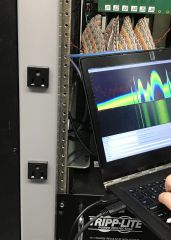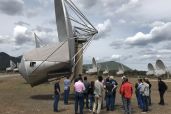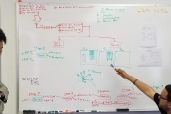By Steve Croft
Berkeley SETI, Breakthrough Listen, the SETI Institute, and the GNU Radio community collaborated to host a hackathon at the Hat Creek Radio Observatory in Northern California last week. HCRO is home to the SETI Institute's Allen Telescope Array, a 42-antenna telescope used to search for radio signals from extraterrestrial intelligence. The GNU Radio community builds open-source hardware and software that is used both by hobbyists who want to explore the radio spectrum (from picking up and visualizing FM radio stations to decoding the signals from airplane transponders) and by professionals who use the tools for commercial and research applications.
The hackathon brought together programmers, engineers, astronomers, and experts in radio hardware and software to collaborate on a range of projects. The 36 participants came from around the US and even from overseas to work on community-focused efforts to make data more easily available, to attach new flexible hardware to the telescopes, to quantify the performance and health of the ATA and other radio observatories, and to help develop new infrastructure and standards.
Some groups plugged GNU Radio hardware directly into the outputs from the ATA's beamformer. Others worked to get data from the ATA into GNU Radio software. Teams made observations of GPS satellites and astrophysical masers, worked on machine learning detection of signals, discussed data archiving, and worked on development of the GNU Radio tools, as well as translating the tools into other languages.
The collaborations that were formed this week are continuing to develop, and we are excited about making more data and tools available to the community! A number of participants are planning to submit their results to the GNU Radio Conference in Huntsville, AL, in September.
Photos: Nathan West, Arash Roshanineshat, Steve Croft, Kyle Logue









